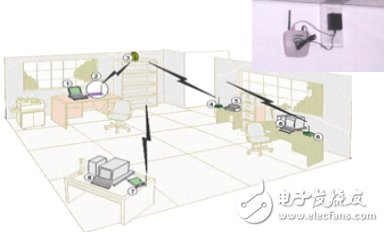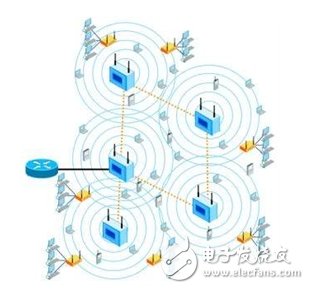In the actual network construction process, TD-SCDMA and WLAN hybrid networking is an effective method to solve the current situation of frequency resource shortage. Multi-technology multi-layer networking and service access control is one of the spectrum resource crisis for TD-SCDMA. Effective initiatives. The WLAN network can play a certain role in making up for the deficiencies of the TD-SCDMA network and improving the data carrying capacity. The WLAN data application scenario analysis and convenient use are issues that need to be considered for WLAN hotspot deployment and service promotion.
China Mobile's data services are increasingly demanding bandwidthWLAN network can play a role in making up for the deficiencies of GSM/TD networks and improving data carrying capacity. At this stage, China Mobile has built a GSM network with the widest coverage, stable operation and high network quality; but GSM supports data services. There is a short board. In theory, the maximum rate of an EDGE user can reach 236.8 Kbps, but the measured data is far from the theoretical data and cannot support the demand of large data services. The TD-SCDMA network has covered provincial and municipal cities. With the construction progress of the fourth phase of the project, TD coverage will be wider, and the TD network will have a certain increase in bandwidth compared to the GSM network. The WLAN service development and the role as a useful complement to the GSM/TD network can be fully realized. The WLAN 802.11g protocol theoretical maximum speed is 54Mbps, the measured data is between 16-30Mbps, and the WLAN 802.11n protocol theoretical maximum speed even reaches 600Mbps. Although in actual applications, due to various obstacles such as distance, wall, other wireless signal interference, encryption and non-encryption, the rate drops greatly, but it still has a great advantage compared with the bandwidth of TD-SCDMA. Can be a powerful complement to the data-bearing business. Therefore, in order to meet the data service needs of mobile terminals in university districts, dense business districts and major roads, Datang Mobile has launched a TD-SCDMA and WLAN access network convergence scheme.
Application of TD-SCDMA+WLAN in indoor distribution engineeringSelection of indoor distributed AP and indoor placement AP
In the indoor distribution project of Datang Mobile, there are mainly two coverage methods of TD-SCDMA+WLAN. One is to use a distributed AP and a combiner to combine the WLAN signal with the TD-SCDMA signal, so that the two signals share a set of antenna feeder systems. The second is to use the indoor placement type AP to cover the indoor hot spot.
The difference between WLAN two coverage methods in indoor distribution
The advantage of using an indoor distributed AP is that the single AP signal covers a large area and is low in cost. The disadvantage is that the user capacity of the WLAN is limited. The advantage of using an indoor placement type AP is that it meets the capacity requirements of the hot spot area. The disadvantage is that if the mass is used, the construction cost is higher than that of the combined way. When constructing a WLAN network, it is recommended to use an indoor AP and an indoor AP to deploy.
Datang Mobile indoor placement type AP combination way. The WLAN signal is evenly distributed to each antenna point by combining with the original room subsystem. As shown in Figure 1, the installation mode of the indoor distributed device ensures that a large number of users simultaneously use the bandwidth requirements of the WLAN network by separately deploying the AP in the hotspot area.

Figure 1 Spotting APs in Hotspots
Application of TD-SCDMA+WLAN in outdoor coverage engineeringIn the outdoor coverage project, Datang Mobile uses the outdoor Mesh AP networking to complete the WLAN coverage, and the TD signal of the macro base station covers the public area together to provide data service services for mobile users. The types of outdoor coverage include residential areas (or buildings with similar structures) and outdoor open areas (such as golf courses, scenic areas, etc.), urban roads (as shown in Figure 2), highways, and the like.

Figure 2 Distribution of urban road AP
Datang Mobile's unique Mesh AP network coverageDatang Mobile Adaptive Mesh Network (Mesh) can quickly complete wireless broadband networking in a short period of time through the intelligent networking mechanism built into each multi-carrier WLAN base station. The small-scale network can be set up in a few seconds to adapt to various emergency networking needs. The base station can be deployed in any topology and flexibly adapt to various networking environments. The number of network nodes can be increased or decreased as needed, as shown in Figure 3.

Figure 3 Networking diagram of Mesh networking
Mesh AP networking has the following advantages:
The network is automatically adjusted and adapted. Therefore, the mobile broadband network is very convenient to move and expand.
The base station can observe the connection status anytime and anywhere, and repair the failed connection. The repair time can be completed in 1 second or even less.
Dynamically perceive changes in the environment and optimize the network: in conjunction with the surrounding wireless environment and service requirements, the transmission link between base stations is automatically optimized.
High reliability: Each node maintains multiple communication links with other nodes. A node fails or is destroyed, and does not affect the entire network to continue to work.
Powerful multi-hop transmission: Each node can relay information to each other. The bandwidth loss per hop is less than 5%, and the delay is less than 2ms.
Adaptive RF planning: Dynamically perceives the surrounding wireless environment for RF allocation and automatic optimization.
Mesh APs can be flexibly configured to cover antenna types, and whip antennas or directional antennas can be selected depending on the project site.
V. SummaryDatang Mobile has adopted indoor scenes such as large office buildings, commercial and residential buildings, hotels, hotels, airports, stations and small conference rooms, bars, leisure centers, as well as public plazas, residential quarters, school campuses, park parks, commercial pedestrian streets, etc. The WLAN coverage of the outdoor scene enables the WLAN network to coexist with the TD network. This measure effectively compensates for the insufficient bandwidth of the TD-SCDMA network and plays a huge role in improving the data carrying capacity of operators.
Interchangeable Power Adapter,5W Interchangeable Power Adapter,20W Interchangeable Power Adapter,Interchangeable Power Adaptor Adapter
Guangdong Mingxin Power Technologies Co.,Ltd. , https://www.mxpowersupply.com